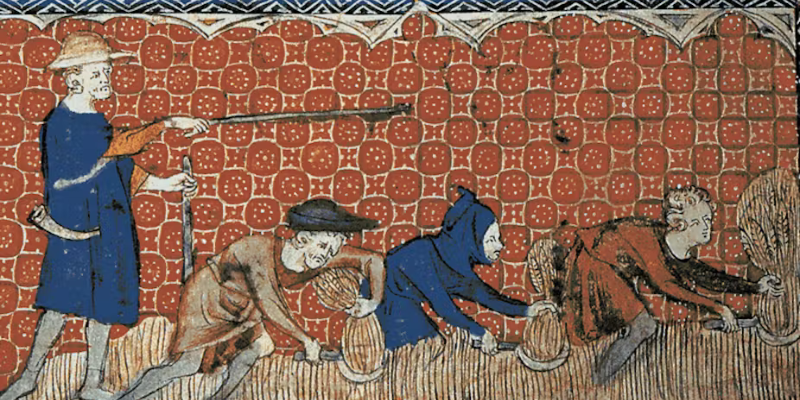Pre-Show History Activity

Use this history-focused activity to get students thinking about the time period depicted in The Lion in Winter to deepen their understanding of what was happening both in Europe and around the world.
History Activity: The Middle Ages
- Activity Preparation
- Supplies:
- Chart paper (one per group)
- Markers
- Sheets of paper (approximately 8.5/11”) (one per student)
- Tablets/Chromebooks (one per student)
- Set-Up
- Group 3-4 students around each chart paper. Be sure each group has a few markers to work with.
- Cue up the video “6 myths about the Middle Ages that everyone believes – Stephanie Honchell Smith.”
- Provide each student with their own piece of paper.
- Supplies:
This activity will take approximately 85 minutes. Part One is approximately 40 minutes and Part Two is approximately 45 minutes.
Part One
- Learning Sequence
- Share or ask a student to share the time frame known as the Middle Ages—between the 500s and 1400s CE/AD. If needed, clarify the difference between the BC/AD and BCE/CE notation systems. Both are based on the Georgian calendar. (~5 minutes)
- Christian notation:
- BC: Before Christ
- AD: Anno Domini, “the year of our Lord”
- Secular notation:
- BCE: Before Common Era
- CE: Common Era
- Christian notation:
- Ask groups to contemplate this question: Based on your prior knowledge, assumptions, and beliefs, what was life like in the Middle Ages in Europe? (~15 minutes)
- If needed, provide additional support to students by displaying a few images that appear in a search result for “Middle Ages” to help spark student thinking.
- Have groups collaborate on their ideas, writing or drawing them on their chart paper. Encourage students to organize and illustrate their thoughts in whatever way they want to. Prompt them to think about as many aspects of life as they can.
- If they need some guidance, provide these as starting points:
- Gender roles
- Family structure
- Politics
- Economy
- Daily life – food, hygiene, work, hobbies, dress, etc.
- Play the video “6 myths about the Middle Ages that everyone believes – Stephanie Honchell Smith.” Consider using closed captions, adjusting the playback speed, or playing the video twice to support student learning needs. (~5 minutes)
- Prompt students to respond to the below discussion questions and direct students to update their chart paper as a group. If time allows, invite a few students to share their reactions and takeaways. (~10 minutes)
- What can you add to your chart paper?
- What did you get correct?
- What misconceptions did you have about life in the Middle Ages?
- Share with students that The Lion in Winter takes place in 1183 CE. Invite them to predict what aspects of this time period they might see onstage. Consider giving students a moment specifically to contemplate the role of gender during this time period historically and in the play. (~5 minutes)
- Share or ask a student to share the time frame known as the Middle Ages—between the 500s and 1400s CE/AD. If needed, clarify the difference between the BC/AD and BCE/CE notation systems. Both are based on the Georgian calendar. (~5 minutes)
Part Two
- Learning Sequence
- The term “Middle Ages” is implicitly Eurocentric. Remind students that the whole rest of the world was also functioning during this time period. Inform students that the next phase of the activity will be exploring what was happening globally during 500-1400 CE. Have each student select a country outside of Europe and conduct basic research to learn about its history during the Middle Ages. (~25 minutes)
- As they did in a group on their posters, students should individually fill their papers with their learning about their chosen country.
- Note that not all countries may have extensive internet resources about their history from 500-1400. Encourage students to pick a particular period within this time frame, or concentrate on a specific event, movement, or historical figure.
- Have students return to their small groups and share their learning with their peers. Prompt each group to consider the similarities and differences between both their chosen countries and their research on Europe in the Middle Ages. (~10 minutes)
- As desired, facilitate a gallery walk, share-out, or discussion between groups or the whole class so students can learn from their peers in other groups. (~10 minutes)
- The term “Middle Ages” is implicitly Eurocentric. Remind students that the whole rest of the world was also functioning during this time period. Inform students that the next phase of the activity will be exploring what was happening globally during 500-1400 CE. Have each student select a country outside of Europe and conduct basic research to learn about its history during the Middle Ages. (~25 minutes)
- This activity aligns with the following standards:
- Illinois Arts Learning Standards
- Anchor Standard 11: Relate artistic ideas and works with societal, cultural, and historical context to deepen understanding.
- Common Core State Standards
- CCSS.ELA.RI7 Integrate and evaluate content presented in diverse formats and media, including visually and quantitatively, as well as in words.
- CCSS.ELA.RI1 Read closely to determine what the text says explicitly and to make logical inferences from it; cite specific textual evidence when writing or speaking to support conclusions drawn from the text
- CCSS.ELA.W7 Conduct short as well as more sustained research projects based on focused questions, demonstrating understanding of the subject under investigation.
- CCSS.ELA.RH6 Compare the point of view of two or more authors for how they treat the same or similar topics, including which details they include and emphasize in their respective accounts.
- Illinois Arts Learning Standards